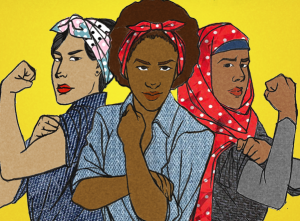
Two people in dress attire are smiling. Another person is out of focus and only their profile is visible.
I looked really good in the pictures.
In the images on my last company’s website, I was the token face of color, the only employee who was not white. As a very light-skinned Filipina, I score less diversity points, but I also present as queer in a way that gentrifying cities like – more like a fashion statement than a radical identity.
My boss told me once that she marketed me to parents as the “cool” one who could appeal to image-conscious teenagers and coach them in their writing. Every time a white Madison Park mother was happy to meet me, I wondered if my tattooed body of color had been a selling point.
I wrote most of the language for our brand, so in print and online, the company’s values mirrored mine.
But behind closed doors, we avoided assessing our structure critically and spent most of our time assuring ourselves we were good people, whether we could attract diverse talent or not.
From my perspective, we had no process of accountability. We didn’t have the capacity for a Human Resources department. My boss was my one point of contact for navigating any conflict or issue, and when it came to my diversity initiative, I had to pace it in time with her emotional readiness. If she stalled or defensively shut down, there were no other avenues to access.
Now that I’ve left, the staff is all white, and I imagine they will be actively recruiting people of color in their next round of hires. I imagine they will tell candidates, “We value diversity. We’ve been working really hard on that front.” They might even add, “We still have work to do.”
But what do these statements mean? Everyone is saying them, and no one is saying or doing much after.
How do these statements help candidates of color determine which systems we are willing to participate in for income?
When recruiters are stubbornly sunny in their sales pitch (“Everyone is welcome here!”), they mislead and potentially harm candidates of marginalized identities. At the very least, organizations need to offer transparency.
So, in this article, I’m going over five questions that an organizational team can reflect on to honestly evaluate themselves and offer candidates of color a more truthful narrative.
1. What Are the Demographics of Your Staff and/or Student Body?
I e-mailed a prospective graduate program this question. Not only did I get a prompt, detailed response, but the coordinator offered no excuses for their incredibly white faculty (exception: one Latina). He wrote that this was an area where they must improve and affirmed the importance of my question.
I was impressed – especially because their student cohort was 52% people of color, and he wasn’t in the least self-congratulatory about it. He understood that representation needs to happen on all levels.
Being a minority in a privileged space is intense psychological and emotional labor.
At a learning services center, I was the only person of color in many, many staff meetings with tender, well-intentioned white people.
When we talked about poverty, trauma, or nontraditional family structures – all more common for our students of color – I sat quietly while a roomful of white women chorused in reaction: “I had no idea…” “I can’t imagine…” “Why didn’t I know about this?”
Over and over again, women in their twenties, thirties, and forties expressed disbelief over my reality or the realities of people close to me. Working at that company reminded me consistently that white people can spend decades overlooking the existence of anyone else.
This isn’t to say that everyone can’t learn at their own pace. But it was lonely to be the only person in those rooms who looked like me and to have the loudest voices be similarly straight, white, and middle-class.
Being the minority is lonely – it impresses upon us in every way that our institutions were not built for people like us to take up space.
Organizations need to be upfront about their demographics and consider publishing their data online. This allows candidates of color to either give informed consent or decline an experience of loneliness and depletion.
If the numbers are not where they need to be, recruiters should call this out and be prepared to explain plans to address it. No excuses. No songbook of lamentations – no “It’s been really hard” or “We’ve been really trying.”
In the absence of organizational progress, I’m more likely to trust someone who presents the hard facts and then validates my concerns.
2. How Does Your Leadership Team Identify Themselves? Can They Name Their Privilege?
Demographics here are helpful for determining the existence of glass ceilings. Are there two men of color in the boardroom, but no women of color, trans or queer people of color, immigrants, and so on? Are the rest of the seats filled by white men and women who are culturally similar?
But beyond a quantitative report, we need to know how leaders view their identities on an internal level.
I had a white boss who avoided saying she was white. She kept identifying as “racially ambiguous.” When I told her I was deeply tired of being the only person of color in our office, she said, “I get it. I used to have an Afro in high school. People thought I was black. Or mixed race.”
I wish she had had the cultural competency in that moment to say, “Tell me more about feeling tired. What are you experiencing?”
Instead, in a post-Rachel Dolezal moment, she claimed that having a black-inspired hairdo in high school was comparable to my lifetime in a body that will never look white and the history that I carry with it.
Over the next year, she would consistently find it challenging to see my unhappiness as valid because she found it challenging to see the differences in our identities as valid.
A white leader can be a strong ally, but they need to be able to say, “I’m white. I’m privileged. I won’t always get it.”
If a white leader is happy to state their marginalized identities – “woman,” “Jewish,” “from a working-class family” – but is reluctant to own their whiteness, they may reactively play the victim anytime their privilege is challenged.
They will not have the emotional capacity to be grateful for feedback. Instead, they’ll weigh their employee’s pain against their own – and typically, their own pain will win.
A person of color needs fair warning of this.
3. How Have You Set Up or Restructured Processes in the Service of Inclusion?
I was considering a teaching residency program.
Before we were to be interviewed, the program invited the finalists of color to a private mixer. Current students and graduates were there to tell us the truth: Every year, the program would invite a diverse group of candidates to come in for interviews and then invariably select a cohort that was whiter than expected for an anti-racist program.
This year, students of color pushed administrators to have a significant portion of the interview be a discussion on race and diversity.
I can only say, Brilliant.
Interviews are set up for cisgender white men to succeed: “Tell us about your accomplishments.” What other population is so rigorously conditioned to list out their accolades and achievements on command?
As a woman of color, I know I have been conditioned to understate my accomplishments and downplay my abilities. But if interviewers asked me my thoughts on race and equity, I mean, I’ve spent my entire life thinking about that.
In the foreword to one of the best essays I have read all year, Chanda Prescod-Weinstein writes, “We must recognize that leading and working with a diverse community that is engaged in the radical act of authoring change is a competency (emphasis mine).”
It is a rare and necessary professional skill. But interviewers rarely know how to listen for it, let alone to even ask for someone’s level of experience.
For everyone to have a fair shot at excellence, we need to question our present standards. In what ways does a white-dominant culture limit how we define success, work, competence, and community?
By holding up whiteness as the universal standard, how are we stifling the unique talents of people of color?
Organizations need to report concrete improvements, and they need to identify who is informing or implementing these changes.
In the example above, the teaching residency program had enough vocal students of color to conceptualize a strategy and then advocate for it. And they received credit for their work.
In many organizations, members of marginalized identities don’t feel safe enough to vocalize their needs. It becomes a leader’s responsibility to empower subcommittees or contract consultants who can inform equitable measures.
Decisions need to be based on the perspectives of people of color.
4. What Have Been the Experiences of People of Color in Your Organization?
I love to teach. Growing up, I was a high-needs student who struggled to connect with my teachers. I love reimagining the teacher-student relationship as reciprocally honest and vulnerable.
I got an acceptance e-mail from a teaching residency program on a sunny afternoon. My body surprised me by shutting down with dread.
The year-long program ends with a five-year job contract with Seattle Public Schools (SPS).
People assured me I could succeed as an employee of the public school system. These people were all straight-identified and either white or Asian American. They said, “It’s hard, but you can do it.”
You can get through it. The hope of marginalized people everywhere.
But what if you can’t? What if you’re not only a person of color, but also queer and radically politicized and the sort of fiery, unpliable spirit that may not last six years in a system of compromise?
I couldn’t ignore my body’s spontaneous crying fits.
I did a new round of informational interviews, seeking out teachers of color with radical politics. Five black women and one Latina woman expressed severe distrust of the system; not one of them told me I would be happy in it.
I am Asian, like a number of folks performing well in the Seattle Public Schools’ system. But I am also queer with radical politics. For me, this means I can’t participate in a system that harms any community of color while benefiting from their labor.
(Let me name what we’re all thinking: My employment opportunities are scarce.)
Organizations should connect candidates with people of similar identities who have experienced their system. But we need to keep in mind that every marginalized identity exists on a spectrum.
A person may know and acknowledge that they’re not white, but they may not feel any personal or political connection to communities of color. This person may be less likely to notice systemic racism or microaggressions.
One person of color might love “playing the game”; another might compromise their health by even entering the game.
If candidates want to do informational interviews, recruiters need to provide a variety of contacts – members who are thriving within the organization and members who are struggling. Not just the success stories. The people in pain, too.
5. Why Is Your Organization Invested In Diversity Work?
My partner works at the intersection of marketing and tech. In Corporate America, I have learned, you pitch diversity as a lucrative business strategy: A more diverse team will know how to reach a more diverse customer base, increasing profits for the company.
I don’t love this. I don’t even like it. But if a corporate headhunter told me this is why they were recruiting me, they would be offering me more transparency than most nonprofit executives do.
Every talking head knows to say, “We value diversity.” But people of color may not trust that statement.
We need to know if leaders understand what’s at stake for us or if they’re only ready to diversify their workforce to prove that they’re not racist (not racist, definitely, definitely not racist) or otherwise prejudiced.
In nonprofit and/or community development sectors especially, people become invested in their identities as kind, thoughtful, open-minded individuals. The situation becomes even more challenging if a person is attached to their identity as a leader for social justice or a global humanitarian – but they use these hijacked terms to replace the word savior.
No one can effectively spearhead a diversity movement if preserving this image is a persistent, underlying concern.
Diversity looks good. Homogeneity looks bad. It makes leaders look bad.
But as a person of color, my body is not your public relations tool.
Why is your organization invested in diversity work? What is your answer that is terrifying in its honesty?
You can tell me that you don’t know. You don’t have the website-ready words, but you can see that people are hurting, and you want to act in service of them. You don’t understand all that people are saying, and you are scared by some of it, but you want to stay present and engaged because you sense that changes will happen with or without you.
Let’s build on this conversation from here.
***
Here is just one possible vision:
White organizational leaders become aware of – but not frozen by – the implications of their whiteness. They realize what they do not know, and they become grateful for the presence of people of color, not as models in their brochures, but as real, vocal stakeholders in an organization’s development process.
People of color thrive, surrounded by mentors who believe our lived experience. We are justly compensated for our labor, and our social safety nets and professional networks are strong. We don’t work out of fear, and we do not seek employment from a place of insecurity.
We feel able to define success for ourselves. We don’t limit our support to those of us who best conform to white supremacy; within our communities of color, we’re energized by the differences among us. As a collective, we reinvent this nation as one that is safe and ready for all of us.
[do_widget id=’text-101′]
Search our 3000+ articles!
Read our articles about:
Our online racial justice training
Used by hundreds of universities, non-profits, and businesses.
Click to learn more
Most Read Articles
- « Previous
- 1
- …
- 30
- 31
- 32



















